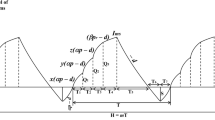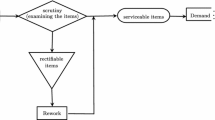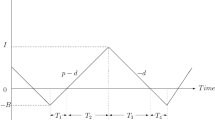Abstract
This study proposes a continuous production inventory model for deteriorating items with preservation technology, rework and price-dependent demand under markdown policy. In this study, we have adopted the markdown policy to reduce inventory cost and clearance at the end of the season or to sell old or slow-moving inventory at the end of its life. Rework is another main factor to reduce production cost and environmental problem. The preservation technology is also considered during product deterioration period to control the deterioration rate of products. The shortages are not allowed. We have also considered that in one cycle, the production system can produce items in several determined replenishment cycles under markdown policy. The aim of this research is to derive the optimal production-run time, the optimal replenishment cycle length, the optimal length of time horizon and the optimal production quantity so as to minimize the total average cost. An example and sensitivity analysis is shown to illustrate the model.







Similar content being viewed by others
References
Benkherouf, L., K. Skouri, and I. Konstantaras. 2017. Optimal batch production with rework process for products with time-varying demand over finite planning horizon. Operations Research, Engineering and Cyber Security 113: 57–68.
Cárdenas-Barrón, L.E., G. Treviño-Garza, A.A. Taleizadeh, and P. Vasant. 2015. Determining replenishment lot size and shipment policy for an EPQ inventory model with delivery and rework. Mathematical Problems in Engineering. https://doi.org/10.1155/2015/595498.
Caro, F., and J. Gallien. 2012. Clearance pricing optimization for a fast-fashion retailer. Operations Research 60 (6): 1404–1422.
Chung, C.J., and H.M. Wee. 2011. Short life-cycle deteriorating product remanufacturing in a green chain inventory control system. International Journal of Production Economics 129 (1): 195–203.
Collado, P.B., and Martínez-de-Albéniz, V. (2014). Estimating and optimizing the impact of inventory on consumer choices in a fashion retail setting, Doctoral dissertation, working paper, IESE Business School, University of Navarra, Barcelona, Spain.
Garg, G., B. Vaish, and S. Gupta. 2012. An EPQ model with price discounting for non-instantaneous deteriorating item with ramp-type production and demand rates. International Journal of Contemporary Mathematical Sciences 7 (11): 513–554.
Hsueh, C.F. 2011. An inventory control model with consideration of remanufacturing and product life cycle. International Journal of Production Research 133 (2): 645–652.
Jaggi, C.K., S. Tiwari, and S.K. Goel. 2016. Replenishment policy for non-instantaneous deteriorating items in a two storage facilities under inflationary conditions. International Journal of Industrial Engineering Computations 7 (3): 489–506.
Mashud, A., M. Khan, M. Uddin, and M. Islam. 2018. A non-instantaneous inventory model having different deterioration rates with stock and price dependent demand under partially backlogged shortages. Uncertain Supply Chain Management 6 (1): 49–64.
Mohammadi, B., A.A. Taleizadeh, R. Noorossana, and H. Samimi. 2015. Optimizing integrated manufacturing and products inspection policy for deteriorating manufacturing system with imperfect inspection. Journal of Manufacturing Systems 37: 299–315.
Moshtagh, M.S., and A.A. Taleizadeh. 2017. Stochastic integrated manufacturing and remanufacturing model with shortage, rework and quality based return rate in a closed loop supply chain. Journal of Cleaner Production 141: 1548–1573.
Namin, A., B.T. Ratchford, and G.P. Soysal. 2017. An empirical analysis of demand variations and markdown policies for fashion retailers. Journal of Retailing and Consumer Services 38: 126–136.
Nobil, A.H., and A.A. Taleizadeh. 2016. A single machine EPQ inventory model for a multi-product imperfect production system with rework process and auction. International Journal of Advanced Logistics 5 (3–4): 141–152.
Nobil, A. H., Afshar Sedigh, A. H., Tiwari, S., and Wee, H. M. (2018). An imperfect multi-item single machine production system with shortage, rework, and scrapped considering inspection, dissimilar deficiency levels, and non-zero setup times. Scientia Iranica. Sharif University of Technology
Pal, S., G.S. Mahapatra, and G.P. Samanta. 2015. A production inventory model for deteriorating item with ramp type demand allowing inflation and shortages under fuzziness. Economic Modelling 46: 334–345.
Palanivel, M., and R. Uthayakumar. 2015. An EPQ model for deteriorating items with variable production cost, time dependent holding cost and partial backlogging under inflation. Opsearch 52 (1): 1–17.
Pour, A.N., and S.N. Ghobadi. 2018. Optimal selling price, replenishment lot size and number of shipments for two echelon supply chain model with deteriorating items. Decision Science Letters 7 (3): 311–322.
Schrady, D.A. 1967. A deterministic inventory model for repairable items. Naval Research Logistics 48: 484–495.
Sekar, T., and R. Uthayakumar. 2017. A multi production inventory model for deteriorating items considering penalty and environmental pollution costs with failure rework. Uncertain Supply Chain Management 5 (3): 229–242.
Sekar, T., and R. Uthayakumar. 2018. A production inventory model for single vendor single buyer integrated demand with multiple production setups and rework. Uncertain Supply Chain Management 6 (1): 75–90.
Sharmila, D., and R. Uthayakumar. 2018. A two warehouse deterministic inventory model for deteriorating items with power demand, time varying holding costs and trade credit in a supply chain system. Uncertain Supply Chain Management 6 (2): 195–212.
Smith S. A. (2015). Clearance pricing in retail chains, In: Agrawal N., Smith S. (eds) Retail supply chain management. International series in operations research and management science, Springer, Boston, 223:387–408.
Srivastava, M., and R. Gupta. 2014. An EPQ model for deteriorating items with time and price dependent demand under markdown policy. Opsearch 51 (1): 148–158.
Tai, A.H. 2013. Economic production quantity models for deteriorating/imperfect products and service with rework. Computers & Industrial Engineering 66 (4): 879–888.
Taleizadeh, A.A., H. Samimi, B. Sarkar, and B. Mohammadi. 2017. Stochastic machine breakdown and discrete delivery in an imperfect inventory-production system. Journal of Industrial and Management Optimization 13 (3): 1511–1535.
Taleizadeh, A. A., Sari-Khanbaglo, M. P., & Cárdenas-Barrón, L. E. (2017b). Outsourcing rework of imperfect items in the economic production quantity (EPQ) inventory model with backordered demand. IEEE Transactions on Systems, Man, and Cybernetics: Systems.
Taleizadeh, A., A.A. Najafi, and S.A. Niaki. 2010. Economic production quantity model with scrapped items and limited production capacity. Scientia Iranica. Transaction E Industrial Engineering 17 (1): 58–69.
Taleizadeh, A.A., H.M. Wee, and S.J. Sadjadi. 2010. Multi-product production quantity model with repair failure and partial backordering. Computers & Industrial Engineering 59 (1): 45–54.
Taleizadeh, A.A., S.T.A. Niaki, and A.A. Najafi. 2010. Multiproduct single-machine production system with stochastic scrapped production rate, partial backordering and service level constraint. Journal of Computational and Applied Mathematics 233 (8): 1834–1849.
Taleizadeh, A.A. 2018. A constrained integrated imperfect manufacturing-inventory system with preventive maintenance and partial backordering. Annals of Operations Research 261 (1–2): 303–337.
Taleizadeh, A.A., S.S. Kalantari, and L.E. Cárdenas-Barrón. 2016. Pricing and lot sizing for an EPQ inventory model with rework and multiple shipments. Top 24 (1): 143–155.
Taleizadeh, A.A., M.P.S. Khanbaglo, and L.E. Cárdenas-Barrón. 2016. An EOQ inventory model with partial backordering and reparation of imperfect products. International Journal of Production Economics 182: 418–434.
Taleizadeh, A.A., and M. Noori-daryan. 2016. Pricing, inventory and production policies in a supply chain of pharmacological products with rework process: a game theoretic approach. Operational Research 16 (1): 89–115.
Taleizadeh, A.A., M. Noori-daryan, and R. Tavakkoli-Moghaddam. 2015. Pricing and ordering decisions in a supply chain with imperfect quality items and inspection under buyback of defective items. International Journal of Production Research 53 (15): 4553–4582.
Taleizadeh, A.A., S.S. Kalantari, and L.E. Cárdenas-Barrón. 2015. Determining optimal price, replenishment lot size and number of shipments for an EPQ model with rework and multiple shipments. Journal of Industrial and Management Optimization 11 (4): 1059–1071.
Taleizadeh, A.A., L.E. Cárdenas-Barrón, and B. Mohammadi. 2014. A deterministic multi product single machine EPQ model with backordering, scraped products, rework and interruption in manufacturing process. International Journal of Production Economics 150: 9–27.
Taleizadeh, A.A., S.G. Jalali-Naini, H.M. Wee, and T.C. Kuo. 2013. An imperfect multi-product production system with rework. Scientia Iranica 20 (3): 811–823.
Taleizadeh, A.A., S.J. Sadjadi, and S.T.A. Niaki. 2011. Multi-product single-machine EPQ model with immediate rework process and back-ordering. European Journal of Industrial Engineering 5: 388–411.
Uthayakumar, R., and S. Tharani. 2017. An economic production model for deteriorating items and time dependent demand with rework and multiple production setups. Journal of Industrial Engineering International 13 (4): 499–512.
Wang, X., Z.P. Fan, and Z. Liu. 2016. Optimal markdown policy of perishable food under the consumer price fairness perception. International Journal of Production Research 54 (19): 5811–5828.
Widyadana, G.A., and H.M. Wee. 2012. An economic production quantity model for deteriorating items with multiple production setups and rework. International Journal of Production Economics 138 (1): 62–67.
Yoo, S.H., D.S. Kim, and M.S. Park. 2009. Economic production quantity model with imperfect-quality items, two way imperfect inspection and sales return. International Journal of Production Economics 121 (1): 255–265.
You, P.S., and Y.C. Hsieh. 2007. An EOQ model with stock price dependent demand. Mathematical and Computer Modelling 45 (7–8): 933–942.
Funding
No funding was received.
Author information
Authors and Affiliations
Corresponding author
Ethics declarations
Conflict of interest
The authors declare that there is no conflict of interest.
Rights and permissions
About this article
Cite this article
Sekar, T., Uthayakumar, R. Determining an optimal replenishment run time and lot size for an imperfect manufacturing system and rework under markdown policy. J Anal 27, 493–514 (2019). https://doi.org/10.1007/s41478-018-0089-2
Received:
Accepted:
Published:
Issue Date:
DOI: https://doi.org/10.1007/s41478-018-0089-2




